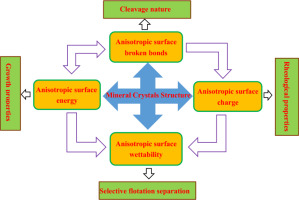Advances in Colloid and Interface Science ( IF 15.6 ) Pub Date : 2018-03-07 , DOI: 10.1016/j.cis.2018.02.004 Longhua Xu , Jia Tian , Houqin Wu , Shuai Fang , Zhongyuan Lu , Caifeng Ma , Wei Sun , Yuehua Hu

|
Anisotropic surface properties of minerals play an important role in a variety of fields. With a focus on the two most intensively investigated silicate minerals (i.e., phyllosilicate minerals and pegmatite aluminosilicate minerals), this review highlights the research on their anisotropic surface properties based on their crystal structures. Four surface features comprise the anisotropic surface chemistry of minerals: broken bonds, energy, wettability, and charge. Analysis of surface broken bond and energy anisotropy helps to explain the cleavage and growth properties of mineral crystals, and understanding surface wettability and charge anisotropy is critical to the analysis of minerals' solution behavior, such as their flotation performance and rheological properties. In a specific reaction, the anisotropic surface properties of minerals are reflected in the adsorption strengths of reagents on different mineral surfaces. Combined with the knowledge of mineral crushing and grinding, a thorough understanding of the anisotropic surface chemistry properties and the anisotropic adsorption behavior of minerals will lead to the development of effective relational models comprising their crystal structure, surface chemistry properties, and targeted reagent adsorption. Overall, such a comprehensive approach is expected to firmly establish the connection between selective cleavage of mineral crystals for desired surfaces and designing novel reagents selectively adsorbed on the mineral surfaces. As tools to characterize the anisotropic surface chemistry properties of minerals, DLVO theory, atomic force microscopy (AFM), and molecular dynamics (MD) simulations are also reviewed.
中文翻译:

硅酸盐矿物晶体的各向异性表面化学性质和吸附行为
矿物的各向异性表面特性在许多领域中都起着重要作用。本文着眼于两种研究最深入的硅酸盐矿物(即页硅酸盐矿物和伟晶岩铝硅酸盐矿物),重点介绍了基于其晶体结构的各向异性表面性质的研究。四个表面特征包括矿物的各向异性表面化学性质:键断裂,能量,润湿性和电荷。表面断裂键和能量各向异性的分析有助于解释矿物晶体的分裂和生长特性,了解表面润湿性和电荷各向异性对于分析矿物的溶液行为至关重要。,例如它们的浮选性能和流变性能。在特定的反应中,矿物的各向异性表面特性反映在试剂在不同矿物表面上的吸附强度。结合矿物破碎和研磨的知识,对各向异性表面化学性质和矿物的各向异性吸附行为的透彻了解将导致开发有效的关系模型,包括它们的晶体结构,表面化学性质和目标试剂吸附。总的来说,这种全面的方法有望牢固地建立起矿物晶体对所需表面的选择性裂解与设计选择性吸附在矿物表面上的新型试剂之间的联系。DLVO理论是表征矿物各向异性表面化学性质的工具,还回顾了原子力显微镜(AFM)和分子动力学(MD)模拟。



























 京公网安备 11010802027423号
京公网安备 11010802027423号